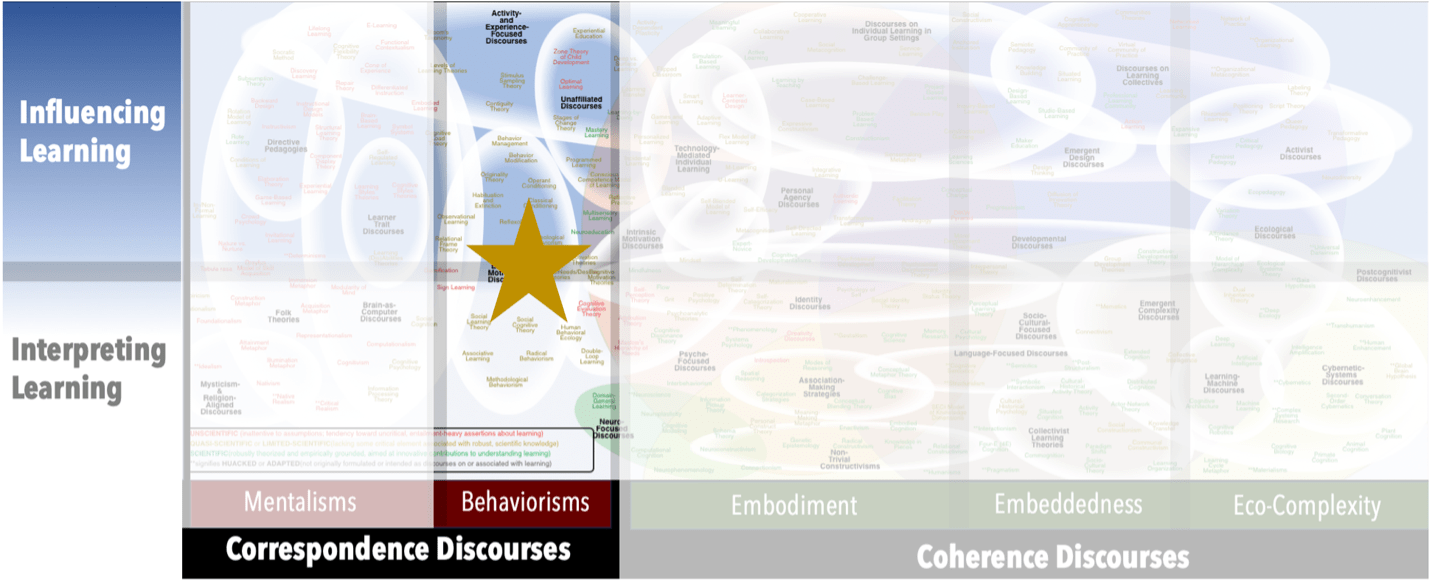AKA
S-R (Bond) Theory
Stimulus-Response Theory
Focus
Forming connections between triggers and reactionsPrincipal Metaphors
- Knowledge is … repertoire of behaviors
- Knowing is … behaving (triggered by stimuli)
- Learner is … an organism
- Learning is … changes in behavior (linking stimuli to responses)
- Teaching is … training; engineering behavior (through deliberate conditioning)
Originated
1910sSynopsis
Thorndike’s Connectionism (which should not be confused with Connectionism (of Cognitive Science)) focuses on Stimulus-Response (S-R) Bonds:- Stimulus–Response Association (Stimulus–Response Association; S-R Bond) (Edward Thorndike, 1910s) – A “stimulus” is a happening that triggers a reaction. A “response” is a reaction to a stimulus. Stimulus-Response (S-R) Bonds are the connections between stimuli and responses.
- Law of Effect (Strong Law of Effect) (Edward Thorndike, 1910s) – when a response is followed with positive reinforcement, there is an increased likelihood that the organism will repeat that response, and when a response that is followed with an aversive consequence, there is a decreased likelihood that the organism will repeat that response
- Weak Law of Effect (Edward Thorndike, 1920s) – a revision of the Law of Effect that omits the second class, regarding the use of aversive consequences and associated suppression of a response
- Law of Exercise (Edward Thorndike, 1910s) – repeating a response will likely help to increase the speed and improve the precision of that response in the future
- Law of Readiness (Edward Thorndike, 1910s) – multiple responses, if already learned, can be chained to achieve a goal (Note: not to be confused with the Readiness Principle; see below.)
- Single-Event Learning – establishing a robust connection between events after just one exposure. The construct is most often encountered in the context of learned fears or aversive responses, but it can be applied to any learning that satisfies the criteria of endurance and a single exposure.
Commentary
See Behaviorisms for general commentary. In terms of commentary that is specific to Thorndike’s Connectionism, the theory appears to have contributed to a tendency among educationists to frame popular advice on teaching in terms of laws and principles:- Laws of Learning (Edward Thorndike, 1910s) – commonly held descriptive assertions on conditions that support learning
- Primacy Principle (Primacy Effect) – What one learns first can be difficult to change, even if it is clearly inadequate or inaccurate.
- Readiness Principle – one’s learning is likely to be more effective if one is prepared for task/concept at hand, which includes attending to both physical needs and conceptual prerequisites (Note: not to be confused with the Law of Readiness; see above.)
- Recency Principle (Recency Effect) – Whatever was most recently learned will be best remembered.
- Intensity Principle – The greater the intensity of the learning experience, the more likely the content will be remembered.
- Freedom Principle – Learning is likely to be more effective if learners are afforded freedom of choice, action, and so on.
- Law of Requirements – To attain a skill or understanding, one must start with something (or from somewhere).
- Just-in-Time – Learning is powerful when it is timed to match preparedness and need. (Just-in-Time is usually used a modifier for “learning,” “teaching,” and related terms.)
Authors and/or Prominent Influences
Edward ThorndikeStatus as a Theory of Learning
Thorndike’s Connectionism straddles our categories of “Discourses on Interpreting Learning” and “Discourses on Influencing Learning.” The theory afforded new insights into the dynamics of learning, but it did so by focusing on laws/principles of influencing learning as is cast mental activity as unobservable and therefore irrelevant.Status as a Theory of Teaching
See “Status as a Theory of Learning,” above.Status as a Scientific Theory
The foci, processes, and interpretations of Thorndike’s Connectionism are clearly articulated and supported by a substantial body of uncontradicted evidence. That said, the theory is constrained by its outright rejection of mental activity as a category of consideration.Subdiscourses:
- Freedom Principle
- Intensity Principle
- Just-in-Time
- Law of Effect (Strong Law of Effect)
- Law of Exercise
- Law of Readiness
- Law of Requirements
- Laws of Learning
- Primacy Principle (Primacy Effect)
- Readiness Principle
- Recency Principle (Recency Effect)
- Single-Event Learning
- Stimulus–Response Association (Stimulus–Response Association; S-R Bond)
- Weak Law of Effect
Map Location

Please cite this article as:
Davis, B., & Francis, K. (2023). “Connectionism (of Behaviorisms)” in Discourses on Learning in Education. https://learningdiscourses.com.
⇦ Back to Map
⇦ Back to List
